

Sannyasa. Sannyasa is a form of asceticism, is marked by renunciation of material desires and prejudices, represented by a state of disinterest and detachment from material life, and has the purpose of spending one's life in peaceful, love-inspired, simple spiritual life.[2][3] An individual in Sanyasa is known as a Sannyasi (male) or Sannyasini (female) in Hinduism,[note 1] which in many ways parallel to the Sadhu and Sadhvi traditions of Jain monasticism, the bhikkhus and bhikkhunis of Buddhism and the monk and nun traditions of Christianity, respectively.[5] Sannyasa has historically been a stage of renunciation, ahimsa (non-violence) peaceful and simple life and spiritual pursuit in Indian traditions.
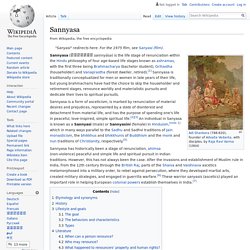
However, this has not always been the case. Etymology and synonyms[edit] In Dravidian languages, "sannyasi" is pronounced as "sanyasi" and also "sannasi" in colloquial form. Sanyasis are also known as Bhiksu, Pravrajita/Pravrajitā,[11] Yati,[12] Sramana and Parivrajaka in Hindu texts.[10] Why Did Thoreau Take the Bhagavad Gita to Walden Pond? The ascetic, mystical love of nature that brought Thoreau to Walden Pond gave him access to the central teaching of the Gita.

He perceived the discipline of living in nature as a path leading toward self-knowledge and spiritual realization. Among the many works of Asian literature that were studied in Concord, Massachusetts, in the mid-nineteenth century, none was more influential than the Bhagavad Gita. Ralph Waldo Emerson wrote of it in his journal of 1845: We'll never share your info. Spam just isn't yogic. "I owed—my friend and I owed—a magnificent day to the Bhagavat Geeta. References to the Gita are found throughout Emerson’s journals and letters, where he frequently quotes from the 1785 translation of Charles Wilkins’s, on which Thoreau’s readings are also based.
The Asian texts that Thoreau and Emerson were reading presented ideas that strengthened their critique of eighteenth-century rationalism and nineteenth-century materialism. YsaLqAf.gif (GIF Image, 500 × 500 pixels) Crushed by the Wheel of Time. Dayananda:"O the great Supreme, in every type of body, either in the heavenly planet or in the hellish planet, there are pleasing and not pleasing circumstances on account of combination and separation.
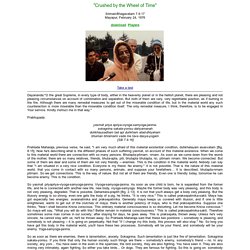
But both of them are very, very regrettable position, as if burning in the fire. Although there are many remedial measures to get out of the miserable condition of life, but in the material world any such counteraction is more miserable than the miserable condition itself. The only remedial measure, I think, therefore, is to be engaged in Your service.
Kindly instruct me in that way. " Prabhupada: yasmat priya apriya-viyoga-samyoga-janma-sokagnina sakala-yonisu dahyamanahduhkhausadham tad api duhkham atad-dhiyahambhuman bhramami vada me tava dasya-yogam [SB 7.9.16] Prahlada Maharaja, previous verse, he said, "I am very much afraid of this material existential condition, duhkhalayam asasvatam [Bg. 8.15]. So yasmat priyapriya-viyoga-samyoga-janma. So we can try to counteract. How to Use a Mala. A mala is a string of beads, used to chant the names of God.

It’s the same thing as prayer beads, or a rosary. A Hindu mala typically has either 108 beads (108 being considered a sacred number in Hinduism) or 27 beads (which is one-fourth of 108). In addition to the 108 or 27 “counting beads,” a mala generally has an additional bead, called the “guru bead,” which hangs perpendicular to the circle of counting beads.
A Hindu mala is usually worked with by using the right hand. Guru Ravidass Jayanti. Guru Ravidass Jayanti is the birthday of Guru Ravidass, celebrated on Magh Purnima, the full moon day in the month of Magh month.
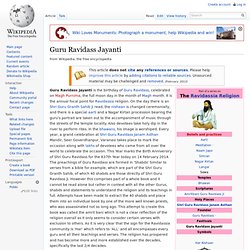
It is the annual focal point for Ravidassia religion. On the day there is an Shri Guru Granth Sahib Ji read, the nishaan is changed ceremonially, and there is a special aarti and a Nagar Kirtan procession bearing the guru's portrait are taken out to the accompaniment of music through the streets of the temple locality.
Also devotees take holy dip in the river to perform rites. In the bhawans, his image is worshiped. Every year, a grand celebration at Shri Guru Ravidass Janam Asthan Mandir, Seer Goverdhanpur, Varanasi takes place to mark the occasion along with lakhs of devotees who came from all over the world to celebrate the occasion. Guru Ravidass. Guru Ravidass Ji (also Raidas, Rohidas[1] and Ruhidas in eastern India) was a North Indian Guru mystic of the bhakti movement who was active in the 15th century CE.
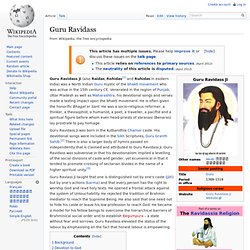
Venerated in the region of Punjab, Uttar Pradesh as well as Maharashtra, his devotional songs and verses made a lasting impact upon the bhakti movement. He is often given the honorific Bhagat or Sant. He was a socio-religious reformer, a thinker, a theosophist, a humanist, a poet, a traveller, a pacifist and a spiritual figure before whom even head-priests of Varanasi (Benaras) lay prostrate to pay homage. Guru Ravidass Ji was born in the Kutbandhla Chamar caste. His devotional songs were included in the Sikh Scriptures, Guru Granth Sahib.[2] There is also a larger body of hymns passed on independently that is claimed and attributed to Guru Ravidass Ji.
Background[edit] The details of Guru Ravidass Ji's life are controversial. Guru Ravidass' origin and parents are also given differently. Devotion to God[edit] He writes:[6] Upanishads. The Upanishads (/uːˈpænɪˌʃædz, uːˈpɑːnɪˌʃɑːdz/;[1] singular: Sanskrit: उपनिषत्, IAST: Upaniṣat, IPA: [upəniʂət̪]; plural: Sanskrit: उपनिषदः) are a collection of texts in the Vedic Sanskrit language which contain the earliest emergence of some of the central religious concepts of Hinduism, some of which are shared with Buddhism and Jainism.
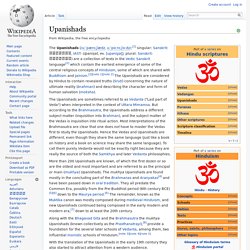
[note 1][note 2] The Upanishads are considered by Hindus to contain revealed truths (Sruti) concerning the nature of ultimate reality (brahman) and describing the character and form of human salvation (moksha). The Upanishads are sometimes referred to as Vedanta ("Last part of Veda") when interpreted in the context of Uttara Mimamsa. Bhagavad Gita. The Bhagavad Gita (Sanskrit: भगवद्गीता, bhagavad-gītā in IAST, Sanskrit pronunciation: [ˈbʱəɡəʋəd̪ ɡiːˈt̪aː]; lit.
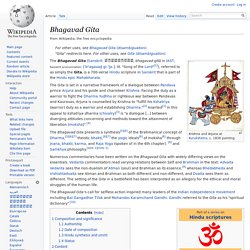
"Song of the Lord"), referred to as simply the Gita, is a 700-verse Hindu scripture in Sanskrit that is part of the Hindu epic Mahabharata. The Gita is set in a narrative framework of a dialogue between Pandava prince Arjuna and his guide and charioteer Krishna. Facing the duty as a warrior to fight the Dharma Yudhha or righteous war between Pandavas and Kauravas, Arjuna is counselled by Krishna to "fulfill his Kshatriya (warrior) duty as a warrior and establishing Dharma. " Inserted in this appeal to kshatriya dharma (chivalry) is "a dialogue [...] between diverging attitudes concerning and methods toward the attainment of liberation (moksha)".
Lemuria (continent) The idea of Lemuria was subsequently incorporated into the proto-New Age philosophy of Theosophy and subsequently into general fringe belief.
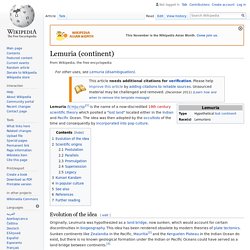
Accounts of Lemuria here differ. All share a common belief that a continent existed in ancient times and sank beneath the ocean as a result of a geological, often cataclysmic, change, such as pole shift, which such theorists anticipate will destroy and transform the modern world. Other scientists hypothesized that Lemuria had extended across parts of the Pacific oceans, seeking to explain the distribution of various species across Asia and the Americas.
The Lemuria theory disappeared completely from conventional scientific consideration after the theories of plate tectonics and continental drift were accepted by the larger scientific community. Some Tamil writers such as Devaneya Pavanar have associated Lemuria with Kumari Kandam, a legendary sunken landmass mentioned in the Tamil literature, claiming that it was the cradle of civilization. Sri Yantra. The Sri Chakra, frequently called the Sri Yantra.
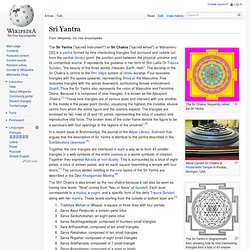
The Sri Yantra in diagrammatic form, showing how its nine interlocking triangles form a total of 43 smaller triangles. In a recent issue of Brahmavidya, the journal of the Adyar Library, Subhash Kak argues that the description of Sri Yantra is identical to the yantra described in the Śvetāśvatara Upanisad.[3] Together the nine triangles are interlaced in such a way as to form 43 smaller triangles in a web symbolic of the entire cosmos or a womb symbolic of creation. Together they express Advaita or non-duality.